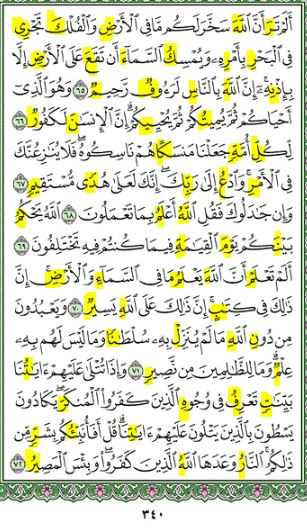
السلام عليكم و رحمة الله,
At this point we now know every single status indicator used in the Arabic language, along with when it’s used. So far, we’ve been looking from the angle of the indicators themselves.
To make it all stick better, we’re going to review by seeing things from another angle: the kinds of words these indicators show up in. To be brief:
المُعْرَباتُ قِسْمانِ: قِسْمٌ يُعْرَبُ بالْحَرَكاتِ وَقِسمٌ يُعْرَبُ بِالْحُرُوْفِ
The words that are given status are two types: one that is given status using harakat (vowels) and one that is given status using letters.
To break it down further, from what we’ve seen while going through the indicators is that they apply to 8 kinds of words, 4 that show status using vowels and 4 that show it using letters:
- The singular noun (الاسْمُ المُفْرَدُ)
- The broken plural (جَمْعُ التَكْسِيْرِ)
- The sound feminine plural (جَمعُ المُؤَنَّثِ السالِمُ)
- The present tense action with nothing attached at the end (الفِعلُ المُضارِعُ لَمْ يَتَّصِلْ بِآخِرِهِ شَيءٌ)
- The dual (المُثَّنى)
- The masculine plural (جَمعُ المُذَكَّرِ السالِمُ)
- The five nouns (الأسْماءُ الخَمْسَةُ)
- The five actions (الأفعالُ الخَمْسَةُ)
المُعْرَباتُ بِالحَرَكاتِ (Words given status using vowels)
فَالَّذِيْ يُعْرَبُ بِالْحَرَكاتِ أرْبَعَةُ أشْيَاء: الاسْمُ المُفْرَدُ وَجَمْعُ التَكْسِيْرِ وَجَمْعُ المُؤَنَّثِ السَّالِمُ وَالفِعْلُ الْمُضَارِعُ الَّذِيْ لَمْ يَتَّصِلْ بِآخِرِهِ شَيْءٌ
The (division) that is given status using vowels is four things: the singular noun, the broken plural, the feminine plural and the present tense action with nothing attached to its end.
There are three vowels: fathah, kasrah and dhammah (sukoon is grouped with them), and there are four kinds of words given status using these (i.e. the first four from the list above):
- The singular noun (الاسْمُ المُفْرَدُ) – For example: ذاكَرَ مُحَمَّدٌ الدرسَ (“Muhammad memorized the lesson”)
- ذاكر is a past tense verb, (so no grammatical state applies here). It’s fixed upon fathah
- ٌمُحَمَّد is the doer of an action, so it’s in raf’, showing it with a dhammah
- الدَرْسَ is the object of the verb, so it’s in nasb, showing it with a fathah
- The broken plural (جَمْعُ التَكْسِيْرِ) – For example: حَفِظَ التلاميذُ الدُرُوسَ (“The students memorized the lessons“)
- حَفِظَ (“memorized”) is a past tense verb, with no grammatical state
- التَلامِيْذُ (the plural of تِلْمِيْذ – student) is the doer with a dhammah on it
- الدُرُوْسَ (the plural of دَرْس – lesson) is the object of the verb with a fathah on it
- The sound feminine plural (جَمعُ المُؤَنَّثِ السالِمُ) – For example: خَشَعَ المُؤمِناتُ في الصَلواتِ (“The believing women were humble in the prayers“)
- خَشَعَ (“was humble”) is a past tense verb
- المُؤمِناتُ (the sound feminine plural of مُؤمِن – believer) is the doer with a dhammah on it
- The word في is one of the particles of jarr
- الصَلاواتِ (the sound feminine plural of صَلاة – prayer) is jarr-ized by the فِي before it, showing that using a kasrah
- The present tense action with nothing attached at the end (الفِعلُ المُضارِعُ لَمْ يَتَّصِلْ بِآخِرِهِ شَيءٌ) – For example: يّذهَبُ مُحمدٌ (“Muhammad goes“)
- يَذْهَبُ (“goes”) is a present tense verb, in raf’ because there’s nothing that will put it into another state. It has a dhammah on it
- مُحَمَّدٌ is the doer with a dhammah on it
The basic rule for words that take status using vowels, and its exceptions
So for these four kinds of words that change status using vowels, you’ve probably noticed a pattern by now, along with a few oddities. To summarize it:
وَكُلُّها تُرْفَعُ بِالضَّمَّةِ وَتُنْصَبُ بِالْفَتْحَةِ وَتُخْفَضُ بِالْكَسْرَةِ وَتُجْزَمُ بِالسُّكُوْنِ, وَخَرَجَ عَنْ ذَلِكَ ثَلاثَةُ أشْيَاء: جَمْعُ المُؤَنَّتِ السَّالِمُ يُنْصَبُ بِالْكَسْرَةِ, وَالاِسْمُ الَّذِيْ لايَنْصَرِفُ يُخْفَضُ بِالْفَتْحَةِ, وَالفِعْلُ المُضَارِعُ الْمُعْتَلُّ الآخِرُ يُجْزَمُ بِحَذْفِ آخِرِهِ
All of them are given raf’ using dhammah, nasb using fathah, khafdh using kasrah and jazzm using sukun, and what goes out of that are three things: The sound feminine plural is given nasb using kasrah, the noun that does not taken tanwin is giving khafdh using fathah, and the present tense verb that has a defective ending is given jazm by dropping its ending
So there you have the basic rule for these first four kinds of words: They are given
- raf’ using dhammah
- nasb using fathah
- jarr using kasrah
- jazm using sukoon
There are only three exceptions to that:
- The feminine plural is given nasb using kasrah
- The partly flexible noun is given jarr using fathah
- The present tense action with a defective ending is given jazm by dropping its final letter
Showing raf’ using dhammah
For these words, they all have a dhammah on them when they’re in raf’, no exceptions. For example:
يُسافِرُ مُحَمَّدٌ وَالْأصْدِقاءُ وَالمُؤمِناتُ (“Muhammad, the friends and the believing women travel”):
- يُسافِرُ (“travels”) is a present tense verb in raf’ with a dhammah on it (there’s nothing here that will put it into another state)
- مُحَمَّدٌ is the doer of the action and in raf’ with a dhammah on it
- الأصْدِقاءُ (the broken plural of صَدِيْق – friend) is connected to مُحَمَّدٌ using و, so it’s also in raf’ with a dhammah on it
- The sound feminine plural المُؤمِناتُ is connected to الأصدقاءُ using و, so it’s also in raf’ with a dhammah on it
Showing nasb using fathah
For nasb, these words all follow the basic rule using a fathah, except that the جمع المؤنث السالم (sound feminine plural) will use kasrah instead. For example:
لَنْ أُخالِفَ مُحَمَّدًا وَالْأصْدِقاءَ وَالمُؤمِناتِ (“I will not contradict Muhammad, the friends and the believing women”):
- أُخالِفَ (“I contradict”) is a present tense verb in nasb with a fathah on it (the لَنْ before it gives it nasb)
- مُحَمَّدًا is the object of the action and in nasb with a fathah on it
- الأصْدِقاءَ is connected to مُحَمَّدًا using و, so it’s also in nasb with a fathah
- The sound feminine plural المُؤمِناتِ is connected to الأصدقاءَ using و, so it’s also in nasb, but with a kasrah on it instead. For more examples of this, you can see Standing tall with نَصْب, Part 3: كَسْرَة
Showing khafdh/jarr using kasrah
For khafdh/jarr, these words follow the basic rule of using kasrah, except that this state doesn’t apply to present tense verbs and that partly flexible nouns (Forgotten what they are? Click here!) use fathah instead. For example:
مَرَرْتُ بِمُحَمَّدٍ وَالْرِجالِ وَالمُؤمِناتِ وَأحْمَدَ (“I passed by Muhammad, the men, the believing women and Ahmad”):
- مَرَرْتُ (“I passed by”) is a past tense verb with no grammatical state
- بِ is a particle of jarr
- مُحَمَّدٍ is in jarr with a kasrah on it (the ب before it gives it jarr)
- الرِجالِ (the broken plural of رَجُل – man) is connected to مُحَمَّدٍ using و, so it’s also in jarr with a kasrah on it
- The sound feminine plural المُؤمِناتِ is connected to الرِجالِ using و, so it’s also in jarr with a kasrah on it
- أحْمَدَ (Ahmad) is a partially flexible noun and is connected to المُؤمِناتِ using و, so it’s also in jarr, but with a fathah on it instead. It’s partially flexible because it’s proper noun that sounds like a verb You should probably review Getting down with خفض, Part 3: فتحة at this point.
Showing jazm using sukun
As we’ve learned before, only a present tense verb can be in jazm. If it has a normal ending (i.e. it doesn’t end with a “defective” letter) it will follow the basic rule and show jazm by having a sukun at the end.
An example of a verb with a normal ending: لَمْ يُسافِرْ خالِدٌ (“Khalid has not traveled”):
- لَمْ is particle that negates that something happened in the past, and it gives jazm to the verb
- يُسافِرْ (“he travels”) is a present tense verb that was given jazm by لَمْ, with a sukun on it
An example of how it happens when the final letter is a “defective” letter, which could be alif (ا), waw (و), or yaa (ي):
لَمْ يَسْعَ بَكْرٌ وَلَمْ يَدْعُ وَلَمْ يَقْضِ ما عَلَيْهِ (“Bakr didn’t strive, nor did he call in prayer, nor did he carry out what he had to do”)
- The verbs يَسْعَ (“strives’), يَدْعُ (“calls in prayer”), and يَقْضِ (“carries out”) are present tense verbs that are given jazm because of the word لم in the beginning.
- They show jazm by dropping the last letter. Initially, they were يَسْعى (the ى dropped), يَدْعُوْ (the و dropped) and يَقْضِيْ (the final ي dropped)
- Tip: The fact that a verb in jazm actually has a vowel on it means that its last letter has been dropped
I really want to cover the words that take status using letters, but this post is already 1400+ words long, so we’ll save that part for later and take a look at a page from the Quran before calling it a wrap. But first, a table to summarize what we’ve just done, with the exceptions in red.
| Raf’ | Nasb | Jarr | Jazm | |
| Fully flexible noun (singular & broken plural) | Dhammah | Fathah | Kasrah | — |
| Partly flexible noun (singular & broken plural) | Dhammah | Fathah | Fathah | — |
| Sound feminine plural | Dhammah | Kasrah | Kasrah | — |
| Present tense verb w/ sound ending | Dhammah | Fathah | — | Sukun |
| Present tense verb w/ defective ending | Dhammah | Fathah | — | Drop last letter |
From the Quran
Below is 22:65-72. If a word is one of the four kinds of words that take status using vowels, I’ve highlighted its ending. I think I’ve got them all, but if you find any that I missed, I’ll give you a shout out in my next update! Most of these endings are pretty easy to follow, so I’m just going to call out a few of the fancier points below.

- The verb تَرَ was تَرى (“you see”), but dropped its final ى when لَم put it in jazm
- تَجْرِيْ and يُحْيِيْ have implied dhammahs, even if you see a sukun on the end (see Implied status and fixed words for more)
- هُدًى has an implied kasrah (because على wants to give it one), but can’t show it.
- The word ءاياتِ is an example of how a sound feminine plural shows nasb using a kasrah. It’s in nasb because it’s the object of the verb يَتْلُونَ (“they recite”).
Questions
- How many divisions do the words that are given status divide into?
- What are the words given status using vowels?
- Give examples of the singular noun in raf’, nasb and jarr
- Likewise for the broken plural
- How is the feminine plural given nasb?
- Give examples of the feminine plural in nasb and jarr
- How is the partly flexible noun given jarr?
- Give an example of a partly flexible noun in raf’, nasb and jarr
- How is a present tense action with a defective ending given jazm?
Until next time, السلام عليكم و رحمة الله و بركاته
Like this post? Simply enter your e-mail for updates!
Leave a Reply